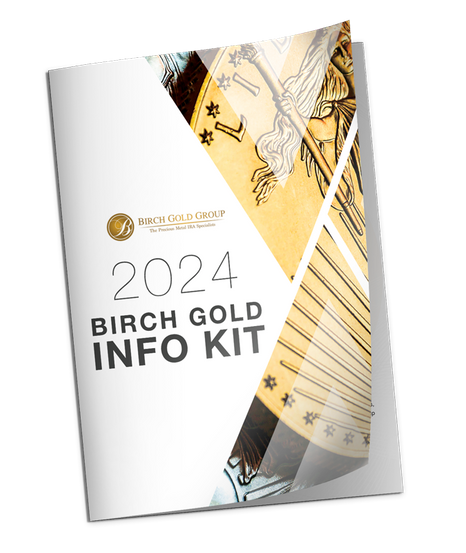“Gold IRA Tax Rules: A Comprehensive Guide”
Disclosure: We are reader-supported. If you buy through links on our site, we may earn a commission. Learn more.
While people put efforts to secure their financial futures, retirement planning has become increasingly complex yet crucial. Among the myriad of options available, Individual Retirement Accounts (IRAs) have long been favored for their tax advantages and flexibility. However, in recent years, a new player has emerged in the retirement investment landscape: The Gold IRA.
In this comprehensive guide, we delve in depth of the details of Gold IRA tax rules, aiming to equip investors with the knowledge necessary to navigate this specialized area of retirement planning. From the fundamental principles of Gold IRAs to the intricacies of tax treatment and strategies for optimizing tax efficiency, this article serves as a roadmap for individuals seeking to harness the benefits of gold within their retirement accounts.
Understanding Gold IRAs
Gold IRAs represent a unique intersection of traditional retirement investing and alternative asset allocation. To grasp their significance within the broader landscape of retirement planning, it’s essential to understand their defining characteristics, benefits, and potential drawbacks.
Definition and Purpose of Gold IRAs
Gold IRAs, also known as precious metals IRAs, are self-directed retirement accounts that enable individuals to invest in physical gold, as well as other precious metals such as silver, platinum, and palladium. Unlike conventional IRAs, which typically consist of stocks, bonds, and mutual funds, Gold IRAs allow for direct ownership of tangible assets.
Claim Your Free Gold IRA Guide From Birch Gold.
The primary purpose of Gold IRAs is to provide investors with a means of diversifying their retirement portfolios beyond traditional financial instruments. Gold, renowned for its intrinsic value and historically stable purchasing power, serves as a hedge against inflation, currency devaluation, and geopolitical uncertainty. By incorporating gold into their retirement accounts, investors aim to mitigate risk and preserve wealth over the long term.
How Gold IRAs Differ from Traditional IRAs
While Gold IRAs share similarities with traditional IRAs in terms of tax treatment and contribution limits, there are several key differences that set them apart:
- Asset Class: Traditional IRAs predominantly consist of paper assets such as stocks, bonds, and mutual funds, whereas Gold IRAs allow for investment in physical precious metals.
- Custodianship: Gold IRAs require a specialized custodian capable of storing and safeguarding physical gold on behalf of the account holder. This contrasts with traditional IRAs, which are typically administered by brokerage firms or financial institutions.
- Investment Options: Gold IRAs offer a broader range of investment options beyond gold, including silver, platinum, and palladium. This flexibility enables investors to tailor their portfolios to their specific risk tolerance and investment objectives.
Benefits of Investing in Gold through an IRA
Investing in gold through an IRA offers several potential benefits for retirement savers:
- Portfolio Diversification: Gold has historically exhibited low correlation with traditional financial assets, making it an effective diversification tool. By adding gold to their retirement portfolios, investors can reduce overall portfolio volatility and enhance risk-adjusted returns.
- Inflation Hedge: Gold has long been recognized as a hedge against inflation, preserving purchasing power during periods of currency debasement and rising prices. Including gold in an IRA can help safeguard retirement savings from the erosive effects of inflation over time.
- Safe-Haven Asset: During times of economic and geopolitical uncertainty, gold tends to serve as a safe-haven asset, attracting investors seeking refuge from market turbulence. By holding gold within an IRA, investors can mitigate downside risk and preserve capital during turbulent market conditions.
Overview of Tax Rules for Gold IRAs
Navigating the tax implications of Gold IRAs is essential for maximizing their benefits and ensuring compliance with IRS regulations. Understanding how contributions, growth, and distributions are treated from a tax perspective is crucial for effective retirement planning. In this section, we’ll provide an overview of the key tax rules governing Gold IRAs.
Related: Gold IRA Rollover – Understanding the Gold IRA.
IRS Regulations Governing Gold IRAs
Gold IRAs are subject to the same tax rules and regulations as traditional IRAs, as outlined by the Internal Revenue Service (IRS). These regulations dictate how contributions are taxed, how investment growth accumulates, and how distributions are treated for tax purposes.
Under IRS guidelines, Gold IRAs must comply with the rules governing traditional IRAs, including contribution limits, distribution requirements, and prohibited transactions. Additionally, Gold IRAs are subject to specific regulations pertaining to the type and purity of allowable precious metals investments.
Request Your Free Gold IRA Guide Today.
Tax Treatment of Contributions to Gold IRAs
Contributions to Gold IRAs are typically made with pre-tax dollars, meaning that they are tax-deductible in the year they are made. This allows investors to reduce their taxable income and defer taxation on the contributed amount until distributions are taken in retirement.
Tax-Deferred Growth and Compounding within Gold IRAs
One of the primary benefits of Gold IRAs is the ability to enjoy tax-deferred growth and compounding on investment returns. Unlike taxable investment accounts, where capital gains and dividends are subject to annual taxation, the growth of investments within a Gold IRA is tax-deferred.
This means that any capital gains, dividends, or interest earned within the Gold IRA are not taxed until distributions are taken in retirement. As a result, investment returns have the opportunity to compound over time, potentially leading to greater long-term wealth accumulation.
Tax Implications of Distributions from Gold IRAs
Distributions from Gold IRAs are treated similarly to distributions from traditional IRAs for tax purposes. When distributions are taken in retirement, they are subject to ordinary income tax rates based on the individual’s tax bracket at the time of distribution.
Additionally, if distributions are taken before reaching age 59½, they may be subject to a 10% early withdrawal penalty imposed by the IRS. This penalty is in addition to any applicable income taxes on the distribution amount.
It’s important for investors to carefully plan their distributions from Gold IRAs to minimize tax liabilities and avoid potential penalties. By understanding the tax treatment of contributions, growth, and distributions within Gold IRAs, investors can make informed decisions to optimize their retirement savings strategy. In the following sections, we’ll explore prohibited transactions and penalties associated with Gold IRAs, as well as tax strategies for maximizing their benefits.
Prohibited Transactions and Penalties
While Gold IRAs offer tax advantages and flexibility, investors must adhere to IRS regulations to maintain their tax-deferred status and avoid penalties. Prohibited transactions within Gold IRAs can result in severe consequences, including the disqualification of the IRA and adverse tax implications. In this section, we’ll examine prohibited transactions and the penalties associated with non-compliance.
Explanation of Prohibited Transactions within Gold IRAs
The IRS prohibits certain transactions within Gold IRAs to maintain the integrity of the retirement savings system and prevent abuse. Prohibited transactions include:
- Self-Dealing: Transactions that involve the IRA owner or certain disqualified persons, such as family members, engaging in direct or indirect personal benefit from the IRA’s assets. This includes purchasing gold for personal use or using IRA assets as collateral for a personal loan.
- Indirect Benefits: Transactions that provide indirect benefits to the IRA owner or disqualified persons, such as using IRA-owned gold to secure a loan for a business owned by the IRA owner.
- Prohibited Investments: Investments in certain types of assets that are prohibited by the IRS, such as collectibles, life insurance, or certain types of precious metals that do not meet IRS purity standards.
Consequences of Engaging in Prohibited Transactions
Engaging in prohibited transactions within a Gold IRA can have serious consequences for investors:
- Disqualification of the IRA: If the IRS determines that a prohibited transaction has occurred within a Gold IRA, the IRA may be disqualified, resulting in the loss of its tax-deferred status. This means that the entire value of the IRA becomes taxable in the year of disqualification, potentially leading to significant tax liabilities for the investor.
- Additional Taxes and Penalties: In addition to the loss of tax-deferred status, investors may be subject to additional taxes and penalties for engaging in prohibited transactions. This includes a 10% excise tax on the amount involved in the prohibited transaction, as well as potential income taxes on any distributions resulting from the disqualification of the IRA.
- Corrective Action: In some cases, the IRS may require the investor to take corrective action to remedy the prohibited transaction and avoid further penalties. This may involve reversing the transaction, restoring the IRA to its original position, and paying any associated taxes and penalties.
How to Avoid Prohibited Transactions and Penalties
To avoid the pitfalls of prohibited transactions and their associated penalties, investors should:
- Familiarize themselves with IRS regulations governing Gold IRAs and prohibited transactions.
- Work with a reputable custodian or financial advisor experienced in Gold IRA investing to ensure compliance with IRS rules.
- Conduct thorough due diligence before making any investment decisions within the Gold IRA to ensure that transactions comply with IRS guidelines.
- Seek professional advice if unsure about the permissibility of a transaction or investment within the Gold IRA.
By adhering to IRS regulations and exercising prudence in their investment decisions, investors can safeguard their Gold IRAs and maximize their tax advantages for long-term retirement savings. In the next section, we’ll explore tax strategies for optimizing the benefits of Gold IRAs while minimizing tax liabilities.
Gold IRA Tax Strategies
Maximizing the tax benefits of Gold IRAs requires careful planning and strategic decision-making. By implementing effective tax strategies, investors can optimize their retirement savings while minimizing tax liabilities both during the accumulation phase and in retirement. In this section, we’ll explore key tax strategies for Gold IRAs.
Related: Gold IRA Scams To Avoid – How to protect your retirement savings.
Maximizing Tax Benefits through Proper Structuring of Gold IRA Investments
- Asset Allocation: Diversifying investments within the Gold IRA across different types of precious metals can help mitigate risk and enhance long-term returns. By spreading investments across gold, silver, platinum, and palladium, investors can capitalize on the unique characteristics of each metal and optimize portfolio performance.
- Dollar-Cost Averaging: Investing a fixed amount regularly in gold within the IRA through systematic purchases, regardless of market fluctuations, can help smooth out volatility and potentially lower the average cost per ounce over time. Dollar-cost averaging takes advantage of market downturns by purchasing more gold when prices are low and fewer ounces when prices are high.
Leveraging Roth IRAs for Tax-Free Growth of Gold Investments
- Roth Conversion: Consider converting a traditional IRA or 401(k) into a Roth IRA to take advantage of tax-free growth potential for gold investments. While Roth conversions involve paying taxes on the converted amount upfront, all future investment gains within the Roth IRA, including those from gold investments, grow tax-free and can be withdrawn tax-free in retirement.
- Estate Planning Benefits: Roth IRAs offer estate planning advantages, as qualified distributions to beneficiaries are typically tax-free. By converting a traditional IRA containing gold investments into a Roth IRA, investors can potentially leave a tax-free legacy for their heirs.
Claim Your Free Guide From Birch Gold Today.
Implementing Tax-Efficient Withdrawal Strategies
- Required Minimum Distributions (RMDs): Once reaching age 72 (or 70½ for those born before July 1, 1949), investors are required to take RMDs from their traditional IRAs, including Gold IRAs. These distributions are subject to ordinary income tax rates. To minimize tax liabilities, consider withdrawing only the required minimum amount each year and strategically timing distributions to optimize tax efficiency.
- Tax Bracket Management: Coordinate withdrawals from Gold IRAs with other sources of retirement income to manage tax brackets effectively. By balancing withdrawals from taxable, tax-deferred, and tax-free accounts, investors can minimize the impact of income taxes on their overall retirement income.
Incorporating Gold Investments into Overall Retirement Tax Planning
- Holistic Approach: View Gold IRA investments as part of a broader retirement tax planning strategy. Consider factors such as Social Security benefits, pension income, and other retirement accounts when crafting a tax-efficient withdrawal strategy that maximizes after-tax income in retirement.
- Professional Guidance: Consult with a qualified financial advisor or tax professional to develop a personalized tax planning strategy tailored to your specific financial situation, risk tolerance, and retirement goals. An experienced advisor can provide valuable insights and recommendations to optimize the tax benefits of Gold IRAs while minimizing tax liabilities.
By incorporating these tax strategies into their retirement planning efforts, investors can harness the full potential of Gold IRAs to build wealth, preserve purchasing power, and achieve financial security in retirement. In the following section, we’ll explore recent developments and legislative changes impacting Gold IRA taxation, as well as strategies for adapting to new tax regulations.
Recent Developments and Legislative Changes
Retirement planning and taxation which comes along are subject to ongoing evolution, with legislative changes and regulatory updates shaping the environment in which Gold IRAs operate. Staying informed about recent developments is crucial for investors seeking to optimize the tax efficiency of their retirement savings. In this section, we’ll explore notable recent developments and legislative changes impacting Gold IRA taxation.
Updates on Recent Changes to Gold IRA Tax Rules
- Tax Cuts and Jobs Act (TCJA): Enacted in 2017, the TCJA introduced significant changes to the tax code, including adjustments that affect retirement accounts such as Gold IRAs. While the TCJA did not directly impact the tax treatment of Gold IRAs, it altered individual tax rates, deductions, and exemptions, which can indirectly influence retirement planning strategies.
- SECURE Act: Signed into law in 2019, the Setting Every Community Up for Retirement Enhancement (SECURE) Act introduced several provisions aimed at expanding access to retirement savings and enhancing retirement security. Key provisions of the SECURE Act include changes to required minimum distribution (RMD) rules, allowing individuals to delay RMDs until age 72 (up from 70½), and eliminating the age limit for making traditional IRA contributions.
Potential Impact of Legislative Developments on Gold IRA Investors
- RMD Changes: The increase in the age for RMDs under the SECURE Act provides additional flexibility for retirees to defer distributions from their Gold IRAs, allowing for continued tax-deferred growth of investments. This can be advantageous for individuals who wish to preserve retirement assets for as long as possible while minimizing current tax liabilities.
- Estate Planning Considerations: The SECURE Act’s changes to RMD rules also impact estate planning strategies for Gold IRA investors. With the ability to delay RMDs until age 72, retirees may have more time to implement tax-efficient estate planning strategies, such as Roth conversions or charitable giving, to optimize the transfer of wealth to heirs.
Strategies for Adapting to New Tax Regulations
- Review and Adjust Retirement Plans: In light of recent legislative changes, investors should review their retirement plans and consider adjustments to take advantage of new opportunities or mitigate potential risks. This may involve revisiting asset allocation strategies, retirement income projections, and estate planning objectives.
- Consult with Financial Professionals: Given the complexity of retirement planning and tax regulations, investors should seek guidance from qualified financial professionals, such as financial advisors, tax advisors, or estate planning attorneys. These professionals can provide personalized advice and help navigate the nuances of Gold IRA taxation in light of recent developments.
- Stay Informed: Legislation and regulatory changes can have far-reaching implications for retirement planning and taxation. Investors should stay informed about developments in tax law and seek educational resources to deepen their understanding of the implications for Gold IRAs and other retirement accounts.
To Learn More About Gold IRA Tax Rule, Request Your Free Gold IRA Guide Today.
Conclusion
Understanding the Gold IRA tax rule is a vital aspect of retirement planning, requiring careful consideration of contribution strategies, investment decisions, and withdrawal planning. In this comprehensive guide, we’ve gone thorough the fundamental principles of Gold IRAs, the intricacies of tax treatment, and strategies for optimizing tax efficiency. By understanding the tax implications of Gold IRAs and implementing strategic tax planning strategies, investors can maximize the benefits of these unique retirement vehicles and achieve their long-term financial goals.
Key takeaways from this guide include:
- Understanding the Basics: Gold IRAs offer investors the opportunity to diversify their retirement portfolios with physical precious metals, providing a hedge against inflation, economic uncertainty, and market volatility.
- Tax Treatment: Contributions to Gold IRAs are typically tax-deductible, and investment growth accumulates on a tax-deferred basis until distributions are taken in retirement. However, distributions are subject to ordinary income tax rates and potential penalties if taken before age 59½.
- Prohibited Transactions and Penalties: Engaging in prohibited transactions within a Gold IRA can result in severe consequences, including the disqualification of the IRA and adverse tax implications. It’s essential to adhere to IRS regulations and avoid prohibited transactions to maintain the tax-deferred status of the IRA.
- Tax Strategies: Implementing tax-efficient strategies, such as asset allocation, Roth conversions, and withdrawal planning, can help investors optimize the tax benefits of Gold IRAs and minimize tax liabilities throughout retirement.
- Expert Guidance: Seeking advice from qualified professionals, staying informed about legislative changes, and planning strategically are essential components of effective Gold IRA tax management.
As you create the knowledge base of Gold IRA taxation, remember to prioritize proactive tax planning, stay informed about regulatory developments, and consult with knowledgeable professionals to make informed decisions tailored to your individual financial situation and retirement goals. By leveraging the tax advantages of Gold IRAs and implementing sound tax strategies, you can enhance the long-term success of your retirement savings journey and achieve financial security in retirement.







